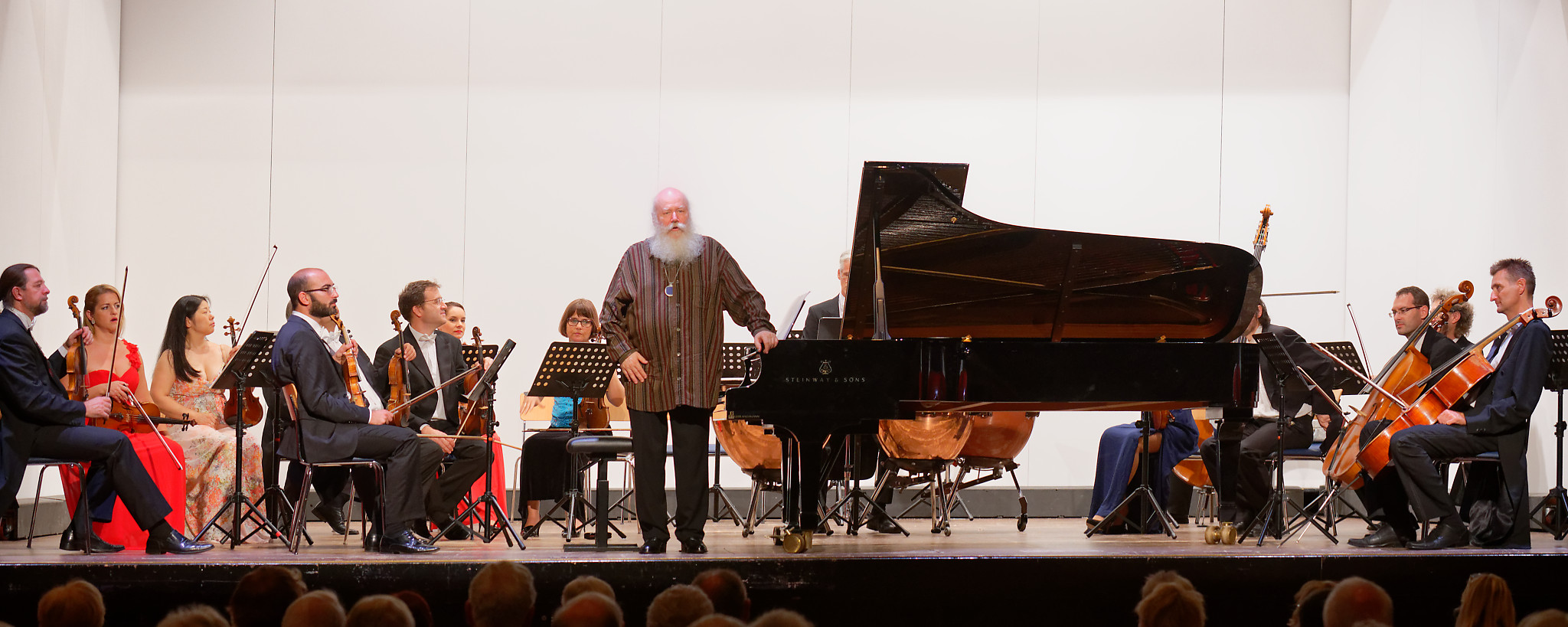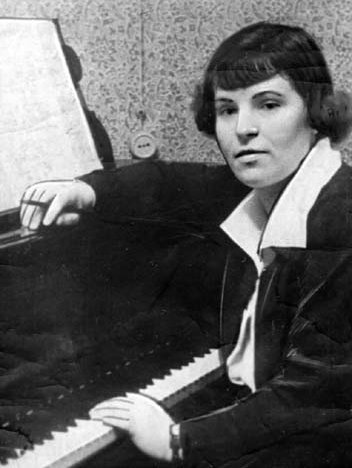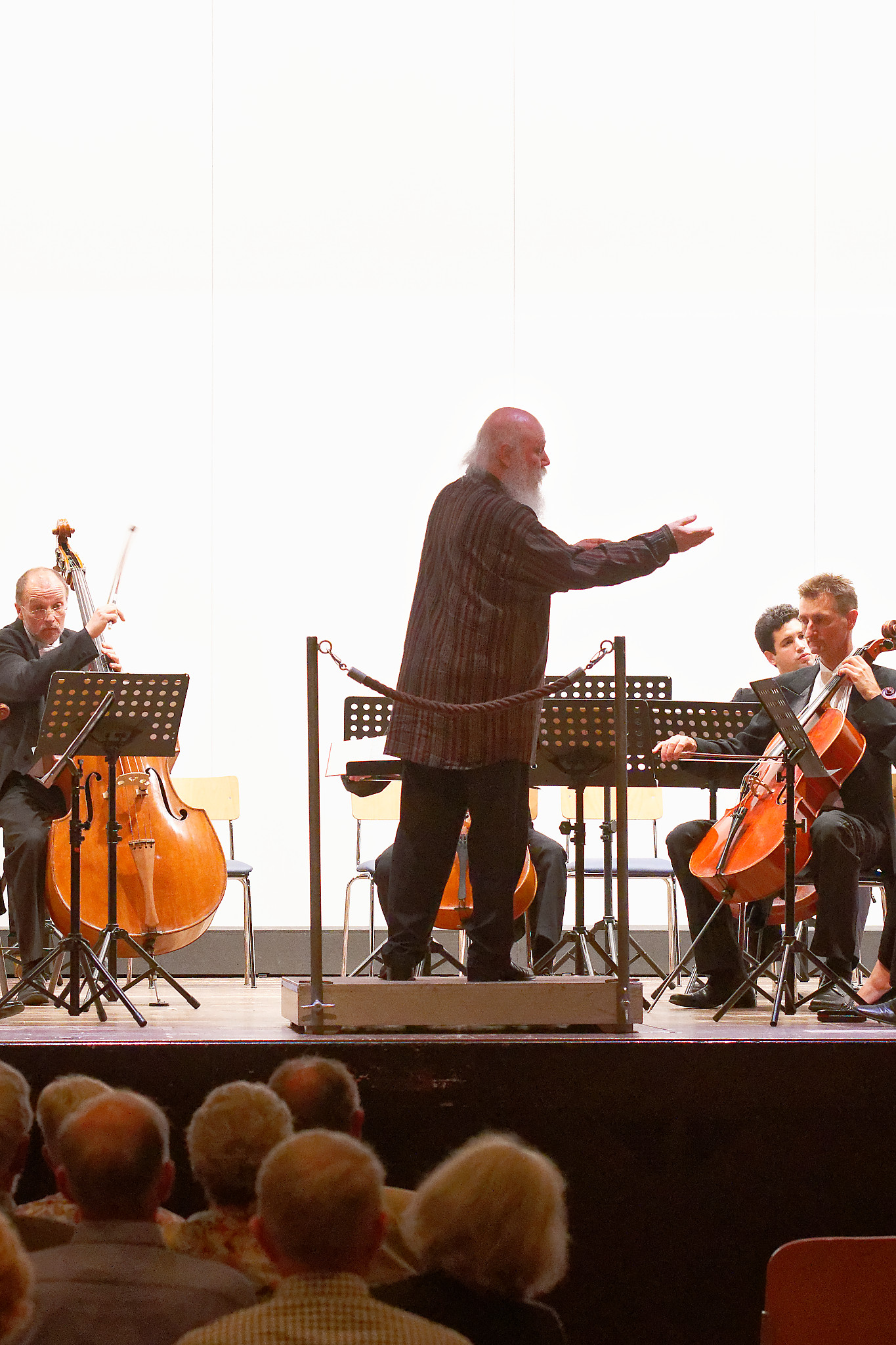Werner Bärtschi, Kammerorchester Arpeggione Hohenems
C.P.E. Bach / Ustvolskaya / Rossini / Mozart
Stadthofsaal, Uster, 2018-09-21

2018-10-13 — Original posting
Table of Contents
Introduction
Venue
After an exhausting series of 10 concerts within less than 3 weeks, this one—right in my neighborhood, in the Stadthofsaal Uster—turned up at very short notice. My wife and I spontaneously decided to attend. Concerts are rare in our provincial town of Uster (locals still call it a “village”, despite its population of over 35,000). The Stadthofsaal is a multi-purpose venue with a small stage, suitable for small-scale theater and concerts of all sorts. The acoustics are OK (not much reverberation, though), the atmosphere—well, whatever one might expect from a venue constructed in the 50’s of 60’s of the last century. I have reported about one other concert in this venue, on 2018-05-17.
The hall can hold up to 600 people (seated). For this concert, there were some 300 seats. However, that day, the auditorium looked more than half-empty, as there were just some 70 people in the audience. While these people gathered close to the podium, my wife and I were sitting in the center of the last row. Acoustically, that’s just as good as seats closer to the stage, but it has the advantage of giving a better view and an opportunity to take unobstructed photos. Several people noted and mentioned that the white cladding of the stage, in combination with the chosen lighting during the performance (from the stage ceiling only) looked particularly interesting, giving just the silhouette for the conductor and the other musicians at the front edge.
Soloist, Conductor
The concert was organized by Top Klassik Zürcher Oberland, an organization offering concerts mainly in the “upper” (i.e., eastern) part of the canton of Zurich. The artistic director of this organization is the pianist, conductor and teacher Werner Bärtschi (*1950, see Wikipedia for more information). I have heard Werner Bärtschi as pianist in a solo recital in Zurich, last spring (2018-03-09). There between two Beethoven sonatas, he played his own music, as well as pieces by composing friends. In this concert, Werner Bärtschi was both conductor and soloist.
Orchestra
Werner Bärtschi had invited a small formation (21 musicians) of the Kammerorchester Arpeggione Hohenems: 16 strings (5 + 4 +3 + 3 + 1), timpani, two French horns, two oboes. As the name indicates, the home base of the Kammerorchester (chamber orchestra) Arpeggione Hohenems is in Hohenems, at the western edge of Austria, one of two locations of the well-known Schubertiade Festival.
It was the artistic director, Irakli Gogibedaschwili (*1947), a Georgian violist, who founded the orchestra in 1990, under the auspices of the city of Hohenems, and of the family of the Count of Waldburg-Zeil-Hohenems. The renaissance castle of the latter serves as the actual home for the orchestra. The Kammerorchester Arpeggione Hohenems is a respectable ensemble of around 60 musicians that is performing not just in Hohenems, but throughout Europe and beyond, and with notable conductors and soloists. What we experienced in this concert, however, was just a small subset of the ensemble.
Program
For this concert, Werner Bärtschi selected four works. At the core of the program was the first “official” composition by the Russian composer Galina Ustvolskaya (1919 – 2006), who would have turned 99 this year:
- C.P.E. Bach: Symphony in A major, Wq.182/4, H.660 (1773)
- Ustvolskaya: Concerto for Piano, String Orchestra, and Timpani (1946)
(Intermission) - Rossini: Sonata a quattro No.3 in C major (1804)
- Mozart: Symphony No.29 in A major, K.201 (186a) (1774)
Werner Bärtschi is making this coming season an “Ustvolskaya year”, in which he will perform a number of works by this composer (typically one per concert). For more information on that composer see below.
General Remarks
All color photos were taken by the author, during the concert in Uster, on 2018-09-21 (© Rolf Kyburz, all rights reserved).

C.P.E. Bach: Symphony in A major, Wq.182/4, H.660 (1773)
Carl Philipp Emanuel Bach (1714 – 1788) is the fifth child, and the second surviving son of Johann Sebastian Bach (1685 – 1750). Born in Weimar, growing up in Weimar and Leipzig, he spent the years 1738 – 1768 in Berlin, and the last 20 years of his life in Hamburg. In 1773, Gottfried van Swieten (1733 – 1803) commissioned six string symphonies, which he wanted to be written in “more difficult style”. These symphonies (all for string orchestra) are now known as “Hamburg Symphonies”, Wq.182:
- No.1 in G major, Wq.182/1, H.657
- No.2 in B♭ major, Wq.182/2, H.658
- No.3 in C major, Wq.182/3, H.659
- No.4 in A major, Wq.182/4, H.660
- No.5 in B minor, Wq.182/5, H.661
- No.6 in E major, Wq.182/6, H.662
Gottfried van Swieten decided to keep the symphonies for himself. Therefore, they were not published during the composer’s lifetime. After their rediscovery, however, the “Hamburg Symphonies” gained widespread popularity. They are now among the most popular of this composer’s works. Werner Bärtschi selected the Symphony in A major, Wq.182/4, H.660, for this concert. The symphony has three movements:
- Allegro, ma non troppo — (attacca)
- Largo ed innocentemente — (attacca)
- Allegro assai
The Performance
The orchestral arrangement was “antiphonal”, with 5 + 4 violins on either side of the podium. That was not only historically correct, but definitely a good idea, with the frequent exchange of motifs between the two voices. The 3 violas were on the rear left, 3 cellos and a double bass in the rear right.
I. Allegro, ma non troppo —
My first impression about the orchestra: a small ensemble with excellent orchestral culture. The tempo was fresh, natural, articulation light and agile. Werner Bärtschi conducted without baton. He still achieved good coordination between the voices: the transition of the motifs between the two violin voices was smooth and seamless.
Just as much as the performance, C.P.E. Bach’s music was grabbing people’s attention: music full of fantasy, and so typical for this composer, with motifs and features that one instantly recognizes as his. The movement is full of dynamic contrasts and surprising harmonic transitions.
★★★½
II. Largo ed innocentemente —
The transition to the second movement is another surprise: the final note of the Allegro is the first note of the Largo. The first violins present a melancholic, very expressive, “talking” cantilena, like an aria in an opera. Sure, the melodies are not nearly as catchy as Mozart’s, but the music is full of expression, and excellent entertainment, for sure!
★★★½
III. Allegro assai
Also the last movement followed (quasi) attacca—and again instantly recognizable. It is full of C.P.E. Bach’s personal, typical topoi, such as the broad, “pulled” portato half notes, contrasting with motoric semiquaver lines, and strong stepped dynamic contrasts.
The movement is quite virtuosic for the small orchestra, and the first violins in particular are very exposed. There were moments where that voice wasn’t entirely homogeneous, and some of the fast, slurred semiquaver motifs were a tad superficial. On the other hand, I definitely liked the playing with very limited vibrato.
The one thing that I regretted was the absence of a harpsichord: a keyboard continuo (ciphered bass line, often also colla parte with the orchestra) is included in the score and should be regarded standard in orchestral music of that time.
★★★
Overall Rating: ★★★½
Ustvolskaya: Concerto for Piano, String Orchestra, and Timpani (1946)
The Composer
Galina Ivanovna Ustvolskaya (Гали́на Ива́новна Уство́льская,, 1919 – 2006) is a Russian composer. She grew up in St.Petersburg (Petrograd back then). 1947, Galina Ustvolskaya graduated from the Leningrad Conservatory, in the class of Dmitri Shostakovich (1906 – 1975), who also supported her against opposition from the Soviet Composer’s Union. While initially she may have adopted features from Shostakovich’s music, she turned to her own style, of which she stated herself: “There is no link whatsoever between my music and that of any other composer, living or dead”.
Ustvolskaya’s oeuvre is small, with less than 30 compositions. Today, she is mostly known for her six piano sonatas, which she composed between 1946 and 1988. And there are 5 symphonies (composed between 1955 and 1990), plus other piano and chamber music, as well as orchestral works. The symphonies all have vocal parts with religious text, and/or religious subtitles.
Concerto for Piano, String Orchestra, and Timpani (1946)
The concerto for Piano, String Orchestra, and Timpani, from her time at the Leningrad Conservatory, is the first composition that she recognized as fully valid. The work is in a single movement, with the following sequence of annotations:
- Lento assai —
- Allegro moderato —
- Andante (cantabile) —
- Pesante —
- Cadenza —
- Largo —
- Grave —
- Pesante


The Performance
The 8 segments were all played attacca, or with minimal rests (quasi attacca). The segments are typically below 2 – 3 minutes each.
Lento assai —
Here now, the Steinway D-274 occupied the center of the stage, the two violin voices were sitting in Werner Bärtschi’s back. The timpani were hidden behind the concert grand, followed to the right by viola & double bass, cellos at the far right. Werner Bärtschi conducted from the piano, sitting. As the pianist announced, the opening (Lento assai) seems to allude to baroque (French) overtures—all ff/fff, with double punctuation, heavy, if not pesante. I would call the opening theme tonal. The violins take over, imitating the piano, which joins in with a contrapuntal motif, and the timpani set strong accents. Dissonances, finally resolving into a harmonious, complacent cantilena.
The concerto is music entirely to Bärtschi’s gusto: he knows how to get the most out of the Steinway’s sonority, without exceeding its capacity—just as he does in his own compositions. On the part of the orchestra, things weren’t always ideal: the small size of the ensemble occasionally had it’s price in the intonation, especially in the violins.
Allegro moderato —
The intonation challenges continued in the heavily polyphonic, fugue-like fast segment that followed. Also, the orchestra was often in danger of getting “snowed in”, covered by the virtuosic solo part. I guess that here, one can hear Shostakovich’s influence in the dissonant polyphony.
Andante (cantabile) — Pesante —
Homogeneity and intonation continued to be a challenge in this serene, polyphonic section. It is baroque-like, but with frequent, dissonant frictions. Interesting music, building up to a strong, expressive (and impressive) climax at the end of the Pesante!
Cadenza —
After the strong climax, the cadenza starts like an idyl, solemn, calm, serene. Even where the piano part is more expressive, the solo is not virtuosic, actually fades away calmly in the end: beautiful music!
Largo —
This section starts with solemn, simple polyphony in cello, viola and the piano, later involving the full orchestra (without timpani), again in baroque “language”, but mildly dissonant / atonal.
Grave — Pesante
The soloist presents the theme, the orchestra joins in, building up to an expressive fff climax, supported by drum rolls / thundering. The melodies are very emotional, the sonority on the piano again full, filling the venue. And again, the orchestra seems a bit too small against the sonority of the concert grand. The latter is especially true when the volume keeps building up, towards the Pesante with its dissonant clusters on the piano, the pounding, heavy rhythm. It’s music that probably reflects the harsh times after the Second World War. The ending, however, is a loud, slow ostinato, turning placatory and tonal: an outlook into a brighter future? Or maybe an outlook into a life beyond?
Rating: ★★½

Rossini: Sonata a quattro No.3 in C major (1804)
1804, when he was just 12, Gioacchino (Giovacchino Antonio) Rossini (1792 – 1868) composed a set of six Sonate a 4:
- No.1 in G major
- No.2 in A major
- No.3 in C major
- No.4 in B♭ major
- No.5 in E♭ major
- No.6 in D major
Each of these Sonate has three movements (fast — slow — fast), and all are written for two violins, cello and double bass. This setting without violas gives them a very special sound, “lacking middle ground”. The sonatas are Rossini’s earliest compositions that survived in today’s concert life (albeit rarely played). Werner Bärtschi selected the Sonata a quattro No.3 in C major, with the following three movements:
- Allegro
- Andante
- Moderato
The Performance
For the second half of the concert, the orchestra returned to the initial, antiphonal arrangement—though here without the violas: the double bass used that space in the rear left.
I. Allegro
Werner Bärtschi chose a good, fluent, natural tempo. It’s lively music, though rather virtuosic. With the missing violas, the violins are very exposed—and their sound not always as homogeneous and coherent as it should / could be. Also, the articulation in the fast semiquaver lines was not always slightly blurred. The single double bass of course had no issue with the homogeneity, and Rossini’s orchestral disposition offered ample opportunity to demonstrate virtuosity and sonority in solo passages!
II. Andante
Throughout the sonata, the orchestra seemed well-balanced, though, in this special disposition without violas, transparency was never an issue. The violins of course remain very exposed. However, clarity in the articulation was not an issue here. I particularly liked the expressive cantilenas, and the surprising, earnest, if not grave “appendix” after the fermata.
III. Moderato
The Moderato begins like a simple, pleasant folk dance. It’s actually a set of variations, where already the first one with its semiquaver triplet line in the first violin develops motorics that are so typical of Rossini in later years. The next variation is another solo for the double bass. Then, the cellos get to play a melodious minore variation. Sound homogeneity was a slight issue here, with three cellists. Maybe it would have been better to take the annotation solo literal? A modulation back to C major leads to the really virtuosic variation with demisemiquaver runs in the violins. Werner Bärtschi’s tempo was at the limits of what the violins could still articulate. The clarity started suffering—even more so with the accelerando in the Coda.
Rating: ★★½

Mozart: Symphony No.29 in A major, K.201 (186a) (1774)
Among the early symphonies by Wolfgang Amadeus Mozart (1756 – 1791), the Symphony No.29 in A major, K.201 (186a) from 1774 is one of the better known works. It is written for strings, 2 oboes and 2 horns and features the following movements:
- Allegro moderato
- Andante
- Menuetto: Allegretto — Trio
- Allegro con spirito

The Performance
Right from the first bars it was very clear: Mozart’s genius stands far above C.P.E. Bach and of course the young Rossini. This Apollonian clarity in the musical gestures, the ingenuity and natural balance in the melodies—a true master composer at work. Very few ever came close to Mozart in the perfection of his melodic inventions, which are devoid of idiosyncrasies. And the composer was only 18 when he completed this symphony!
As in the symphony by C.P.E. Bach, I missed the rhythmic support by a harpsichord. Unlike C.P.E. Bach, Mozart did not leave any indications to that effect, but clearly, such performances were “conducted” from a harpsichord at that time, not by a conductor, or from the first desk / by the concertmaster.
I. Allegro moderato
Not just from the composition, but also from the performance, the music sounded natural—it made people “feel at home”. One instantly realized that the orchestra is intimately familiar with Mozart’s music. Bärtschi selected a seemingly fluent tempo—perfectly adequate, given the alla breve notation. The articulation was light, but mellow, “f accents” with acciaccatura present, but not over-emphasized. As a listener, one even got a taste of Mozart the entertainer, with the little surprises, maybe even jokes that he added to his music, e.g., in the development part, or in the Coda.
II. Andante
A serene idyl, calm, expressive. Mozart (and the initial symphony by C.P.E. Bach) showed the orchestra at its best. Here, the use of mutes made the violin voices sound even more homogeneous. It’s the violins that dominate the stage, the accompaniment in the low strings is simple, the wind instruments either support the harmonies, or they play colla parte. Despite the relaxed pace, Bärtschi managed to keep the flow, never to drop the tension (this may sound trivial, but it isn’t!).
III. Menuetto: Allegretto — Trio
Also here, Werner Bärtschi convinced with an excellent, natural tempo choice. The articulation remained light, although the small notes in the punctuations could maybe have been a little more separated, more distinct. From the little surprises and jokes, one could feel how Mozart was approaching the Scherzo character. The lyrical Trio, at its slightly slower pace, though, made it clear that this is still early classical music.
IV. Allegro con spirito
Again, Werner Bärtschi selected a fresh tempo. It was so fresh that the orchestra just still managed to articulate the semiquaver figures. A joyful movement, truly Apollonian—certainly in the exposition! Mozart of course could not resist adding surprises, such as unexpected harmonic turns, sudden transitions, or the surprisingly abrupt ending.
Excellent music throughout, and the perfect way to end the concert!
Rating: ★★★


















